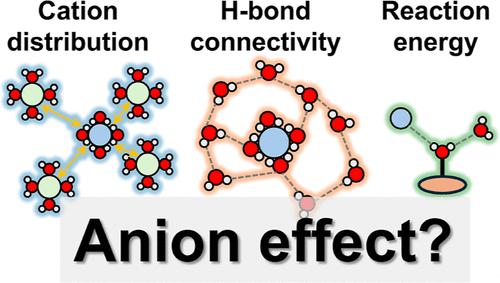揭示阴离子对电极附近氢键网络的影响及单原子电催化剂的活性
IF 15.6
1区 化学
Q1 CHEMISTRY, MULTIDISCIPLINARY
引用次数: 0
摘要
虽然人们对单原子催化剂的电化学性能进行了大量的研究,但电解质阴离子对其电化学活性的影响在很大程度上仍未被探索。我们进行了多尺度分子动力学(MD)模拟,以研究阴离子如何影响SAC电极/电解质界面附近的氢键网络和相关的水解离动力学。恒电位MD模拟表明,在界面处存在两个不同的氢键间隙区,氢键连通性可能对阴离子类型和电极电位高度敏感。特别是在界面上,阴离子吸附强度的差异会导致氢键连通性的相反趋势。从从头算MD模拟中获得的另一个关键见解是阴离子充当主动调节剂而不是被动旁观者。由于局部氢键环境的不对称性,非特异性阴离子吸附倾向于调节水的活化。总的来说,分子水平上对阴离子在SAC电极/电解质界面上的影响的深入了解将导致新的电解质工程策略来优化电化学性能。本文章由计算机程序翻译,如有差异,请以英文原文为准。

Unravelling the Effects of Anions on the Vicinal H-Bonding Network near an Electrode and Activity of Single-Atom Electrocatalysts
While extensive research has been devoted to studying the electrochemical performance of single-atom catalysts (SACs), the impact of electrolyte anions on their electrochemical activity remains largely unexplored. We performed multiscale molecular dynamics (MD) simulations to examine how anions affect the vicinal hydrogen-bonding network and associated water dissociation dynamics at the SAC electrode/electrolyte interface. Constant-potential MD simulations demonstrate the presence of two distinct hydrogen bond gap regions at the interface and that hydrogen bond connectivity may be highly sensitive to the anion type and electrode potential. In particular, at the interface, differences in anion adsorption strength can lead to opposite trends in hydrogen bond connectivity. Another key insight obtained from ab initio MD simulations is that anions act as active modulators rather than passive bystanders. Nonspecific anion adsorption tends to modulate water activation due to the asymmetry in the local hydrogen-bonding environment. Overall, molecular-level insights into the effects of anions at the SAC electrode/electrolyte interface will lead to new electrolyte engineering strategies to optimize electrochemical performance.
求助全文
通过发布文献求助,成功后即可免费获取论文全文。
去求助
来源期刊
CiteScore
24.40
自引率
6.00%
发文量
2398
审稿时长
1.6 months
期刊介绍:
The flagship journal of the American Chemical Society, known as the Journal of the American Chemical Society (JACS), has been a prestigious publication since its establishment in 1879. It holds a preeminent position in the field of chemistry and related interdisciplinary sciences. JACS is committed to disseminating cutting-edge research papers, covering a wide range of topics, and encompasses approximately 19,000 pages of Articles, Communications, and Perspectives annually. With a weekly publication frequency, JACS plays a vital role in advancing the field of chemistry by providing essential research.

 求助内容:
求助内容: 应助结果提醒方式:
应助结果提醒方式:


